Camborne and Redruth Tramways
History
The 3ft 6in-gauge Camborne and Redruth Tramways were owned by the Urban Electric Supply Company, which operated both its tramway systems (Glossop Tramways, and Camborne and Redruth Tramways) directly rather than through subsidiary companies. The UESCo was itself a subsidiary of Edmundson's Electricity Corporation, which controlled numerous electricity supply companies across the country, as well as the Scarborough Tramways Company.
The UESCo and its parent company, the EEC, were both formed in 1897, an application for a light railway order for a circa 9-mile tramway between Camborne, Redruth and Portreath being submitted late in the following year. The application was, however, rejected, both as a consequence of tight curves and narrow roads, as well as objections from the Great Western Railway (GWR). The UESCo returned with an amended application in 1900 for a much shorter tramway, between Camborne and Redruth, and was this time successful. Construction started on the 7th April 1902, with the official opening taking place seven months later on the 7th November. The system was essentially a long single line with intermediate loops, running from a terminus in Trelowarren St, Camborne, roughly northeastwards through Tuckingmill to Pool, where it took a more easterly course through Illogan Highway and Blowinghouse to a terminus in West End, Redruth, in total 3.4 miles. The route was crossed on the level by three railway lines — the GWR's North Roskear, North Crofty and Portreath branches — which thankfully for the tramway did not have any passenger services.
The system was unique in the British Isles in carrying ore from the mines at East Pool and Wheal Agar to the ore crushing stamps and processing plant at Tolvaddon, about a mile away, services which commenced in November 1903. The mineral trains were hauled using purpose-built electric tram locos, which ran along the main tramway line between the mines and the stamps. Other than the connecting lines to the tin stamps at Tolvaddon and the mines in Pool, the tramway was never extended.
The tramway was reasonably successful, carrying over a million passengers in its first twelve months, though it was, like its sister enterprise in Glossop, heavily dependant on the vagaries of a single industry, in this case the local tin mines. Although the tramway made a profit, the returns were never really high enough to justify the initial expenditure, the company being therefore reluctant to involve itself in any additional expenditure, including it would seem, adequate track maintenance. This led to conflict with the local councils, which was only resolved in 1911/1912 when Cornwall County Council relaid (and raised) the road, the company having to raise and relay its tracks accordingly.
The company also operated a successful parcels and postal service, these items being carried on the trams, the former being delivered (within in a certain radius) by the company's parcels boys (initially a parcels porter), and the latter collected from the trams (which had a basket on dash specifically for this purpose) by Post Office workers.
Like most systems, Camborne and Redruth Tramways suffered during the Great War from a loss of skilled staff, which together with severe restrictions on the availability of materials and spares parts, resulted in the absolute minimum of maintenance being carried out. Skilled workshop employees were impossible to replace, but those working on the trams were another matter, many tramways around the country eventually employing woman to make up for the male staff lost to the armed forces. Perhaps uniquely amongst British tramway systems, the first two female Great War employees were actually inspectresses, this unusual step being taken in March 1917, following the call-up of one of the system's two male inspectors, the first conductresses only following in May 1917. Most of the ladies were dismissed during 1920, though one inspectress remained until 1925, and possibly the odd conductress as well.
The tramway appears to have been put back into reasonable order following the conflict, though any thoughts of major renewals evaporated completely in the early 1920s following a severe downturn in the tin industry, several major mines closing, and East Pool and Agar Mines ceasing to work (other than maintenance and pumping) in the hope of an upturn. This was compounded in May 1921 by a significant underground collapse in East Pool which meant that any further working could not be undertaken until a new shaft had been sunk. Mineral tram operation therefore ceased completely between early 1921 and the opening of the new shaft in December 1923. The impact on the tramway's finances was fairly predictable, with only a small profit being made in 1921 and 1922. The company reacted by reducing operating costs, returning the system to profit in 1923, though this was only temporary, losses being made the following two years, a situation that was further exacerbated by bus competition, from the Cornwall Transport Company, in 1926. The writing was now on the wall, and as in Glossop, the USECo offered the tramway free of charge to the local councils, with unfortunately, the same outcome, i.e., no takers. In September 1927, the company notified the councils of its intention to withdraw passengers services, and with no objections forthcoming, the last tram ran on the 29th September 1927.
The mineral tramway, however, remained in operation, though the profits it generated were hardly spectacular. One reason for this was that the company had to maintain infrastructure at its Carn Brea depot (e.g., converters), that was only used for this purpose, the lion's share of electricity generation having for many years been provided by a plant at Hayle operated by another UESCo subsidiary. The company eventually decided that these costs needed to be fully borne by the mining company, with the result that an aerial ropeway was eventually built, the last mineral tram running in August 1934.
Uniforms
Staff working the newly inaugurated electric services were provided with dark blue, double-breasted, lancer-style tunics with five pairs of buttons (narrowing from top to bottom). The buttons bore the company's initials — UES — in intertwined script initials — and were brass (see link). The tunics were piped in green and had stand-up collars; the bearer's left-hand collar carried a staff number in individual numerals (prefixed with ‘No’), whilst the right-hand collar carried the company initials in individual letters ('U E S Co L T D’). Although staff of the UESCo's only other system (Glossop Tramways) had similar insignia, they had neither the 'No' prefix nor the 'LTD' suffix. The peaked caps initially had soft convex tops, these being superseded by caps with tensioned crowns (tops) in the late-Edwardian era; both types bore off-the-shelf, script-lettering grade badges — either Motorman or Conductor — which were almost certainly brass to match the buttons. The lancer-style tunics only lasted for a short while, being replaced in 1904 by single-breasted jackets (with five buttons) and stand-up collars; the uniform insignia remained, however, unchanged.
The style of the jacket was at some point subtly altered, the stand-up collars being superseded by fold-over collars; these continued to carry insignia, probably the same as that carried earlier, though this cannot be made out with certainty on surviving photographs.
Motormen and conductors were also issued with double-breasted greatcoats; it is currently unclear what insignia, if any, these carried.
In the early years (at least) the tramway employed the services of a Parcels Porter. The uniform worn was identical to that worn by tramcar crews, but with a Porter script-lettering cap badge. As far as I am aware, this is the only UK tramway that used this particular designation, all other systems with similar grades using Parcels cap badges.
Mineral trams were crewed by two men, a motorman and a brakeman. Motormen initially wore the same uniforms as their colleagues working the passenger trams, whereas brakemen wore heavy-duty workmen's clothing. The mineral tramway outlasted the passenger services by almost seven years, a period during which motormen abandoned uniforms in favour of robust workmen's attire.
Somewhat unusually, inspectors were initially issued with the same style of uniform as tramcar crews, including an employee number on the collar, the sole difference being the use of a script-lettering 'Inspector' badge on the cap; these appear to have been brass rather than embroidered, the latter being the norm on the vast majority of UK tramway systems for senior grades such as this. The use of uniforms that were virtually identical to those of tramcar crews was also practiced at the tramways sister system, Glossop Tramways. At some point, probably around the time of the Great War, the jackets were changed to a more modern double-breasted design with lapels and four pairs of buttons; the collars carried the grade — 'Inspector — in embroidered script lettering. The style of cap was probably changed in the late-Edwardian era, from the earlier soft-topped type to a style with a tensioned crown; the latter bore the grade — 'Inspector — carried on a hat band in embroidered script lettering.
The company also employed the services of female staff, who were taken on during the Great War to replace male staff lost to the armed services; however, unlike the vast majority of UK tramways, the C&RT continued to employ them after the war, at least until 1920, and quite possibly beyond. Very few photographs of these ladies have survived, with only a single image from 1920 available to confirm the uniform details; this shows that conductresses were issued with long, tailored, single-breasted jackets with five buttons, a waist belt (with button fastening) and lapels; the collars carried embroidered script lettering, very probably the grade. The women were issued with trousers and gaiters rather than skirts, an approach used on a few other systems that served mining district (e.g., Pontypridd Urban District Council Tramways). Headgear took the form of a baggy peaked cap, sometimes referred to as a motor cap; this carried a script-lettering grade badge — Conductor — though whether this was metal or embroidered is currently unclear. Two inspectresses were also employed; these ladies wore long double-breasted coats with lapels, the upper part of which (i.e., the collars) bore the grade — 'Inspector — in embroidered script lettering. Headgear took the form of a felt bonnet with a hat band; whether or not the latter carried the bearer's grade is currently unclear.
Further reading
For a history of Camborne and Redruth Tramways, see: 'Cornwall's Electric Tramcars' by L Fisher Barham; Glasney Press (1972).
Images
Motormen and conductors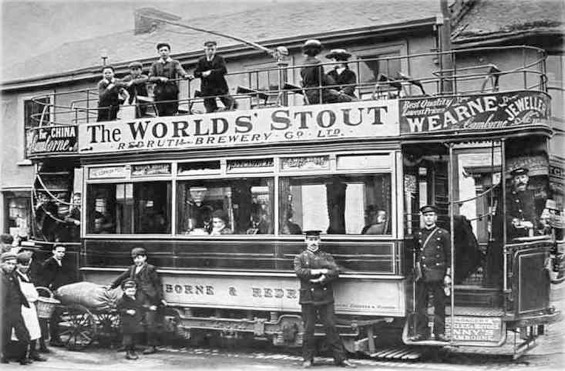
Tramcar No 1 stands at the Camborne terminus in the charge of Motorman W Hampton and Conductor A Wallace in 1903. Both men are wearing lancer-style tunics. The man standing in front of the car with his arms folded is more than likely an inspector, a grade which on most other tramway systems would have been provided with a more elaborate uniform, but here only merited a grade badge on the cap to distinguish the bearer from lower grades. Photo courtesy of the Tramways and Light Railway Society, with thanks to David Voice.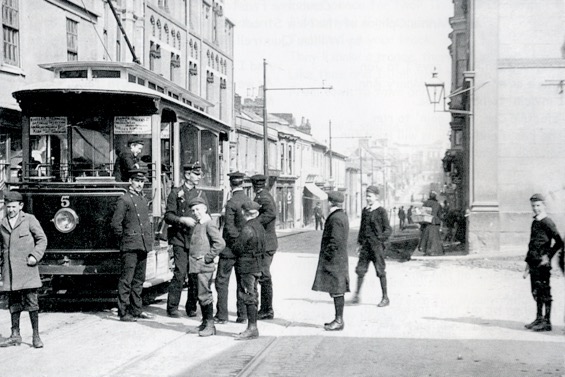
A favourite spot for local photographers, looking up Trelowarren St from the Camborne terminus. This view shows the crew of single-decker No 5 in 1903 — the conductor is a Mr J West. Photo courtesy of the Tramways and Light Railway Society, with thanks to David Voice.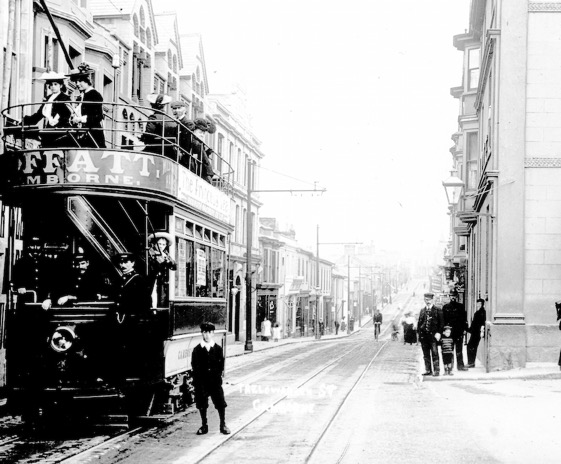
A rather under-exposed shot, at least as far as the tramwaymen are concerned, but one which does show the new single-breasted jackets, which appear to have been introduced in 1904, the year in which the photograph was probably taken. The tramcar is standing at the Camborne terminus in Trelowarren St. With thanks to the National Tramway Museum. 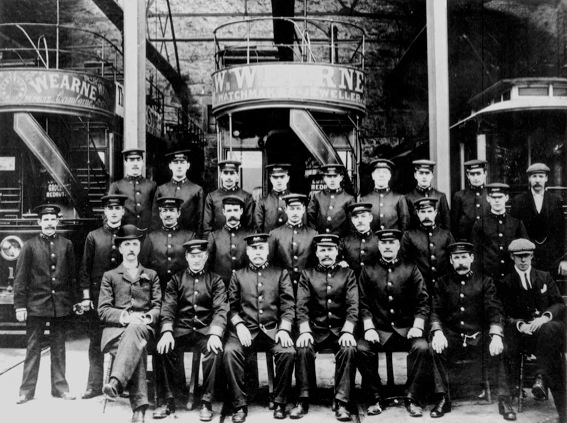
Camborne and Redruth Tramways staff photo taken in 1905 at the tramway depot at East Hill. With thanks to the Cornish Studies Library (see link).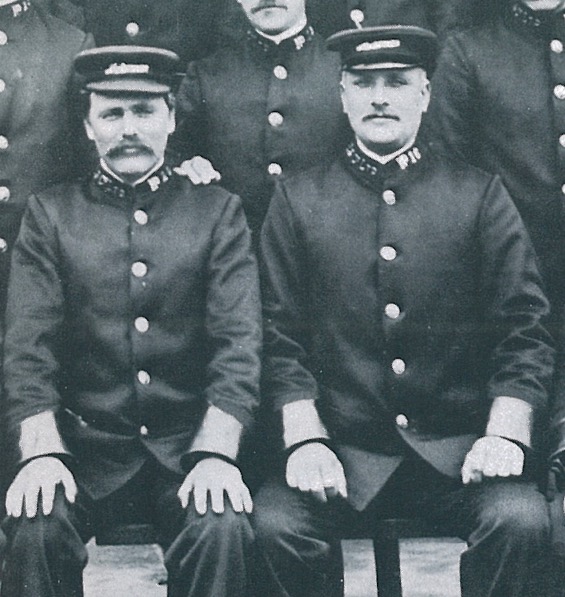
An enlargement of the above photograph showing two of the motormen, J Cock and J Williams. The collars bear an employee number (on the bearer's left) and system initials, 'U E S Co L T D' (on the bearer's right).
Standard off-the-shelf, script-lettering grade badges of the type used by Camborne and Redruth Tramways on tramcar crew caps — brass. Author's Collection.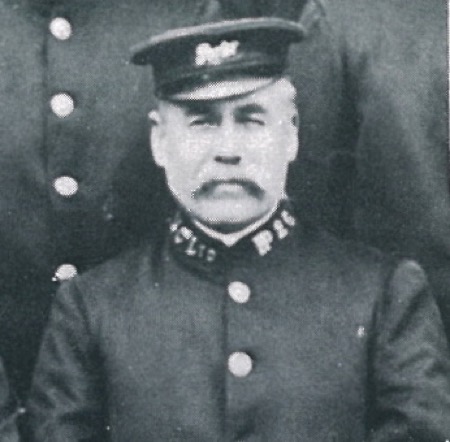
Another enlargement of the above photograph, this time showing Mr P Holman, who was a Parcels Porter; his cap carries a Porter grade badge.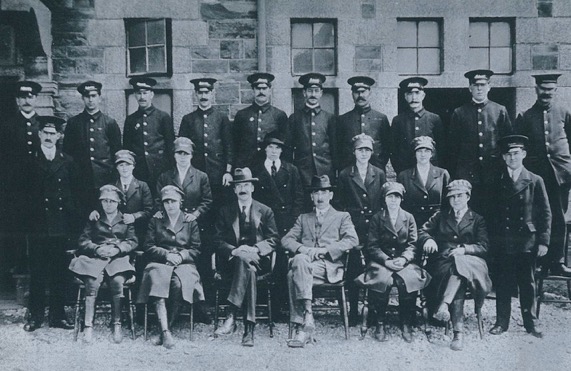
A staff photo taken at the tramway company offices in 1920. Rather than the stand-up collars of the earlier jackets, those depicted here have fold-over collars.
Mineral loco motormen and brakemen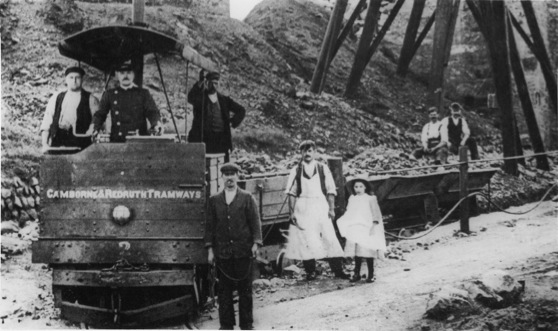
Motorman J Williams with Brakeman Bill Hampton aboard Mineral Tram No 2, about to depart from East Pool Mine with a load of tin ore — photo circa 1903/4. Motorman Williams's tunic is lacking his left-hand line of buttons; these actually had no practical function, so had presumably been removed because they got snagged during his more onerous mineral tram duties. Photo courtesy of the Tramways and Light Railway Society, with thanks to David Voice.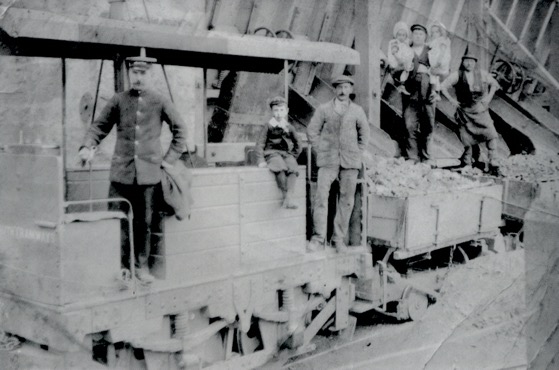
A motorman and a brakeman with a mineral tram at East Pool Mine ore bin chutes — photo undated, but probably mid Edwardian. Photo courtesy of the Tramways and Light Railway Society, with thanks to David Voice.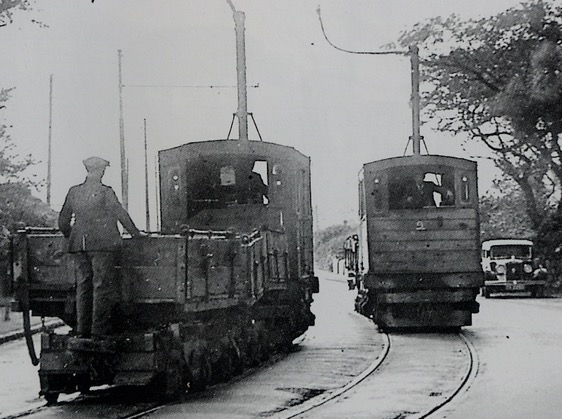
Mineral trams No 1 and No 2 pass each other at the Trevenson Loop — photo undated, but probably taken in the early 1930s. The motorman (right) and brakeman (left) are wearing informal attire. Photo courtesy of the Tramways and Light Railway Society, with thanks to David Voice.
Senior staff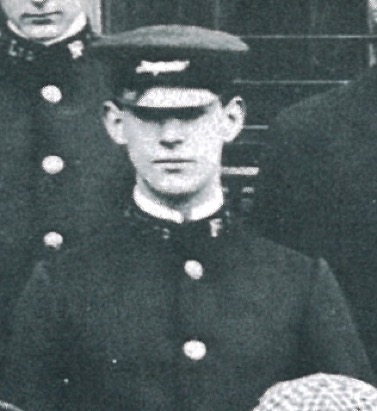
An enlargement of the 1905 depot photograph above showing one of the inspectors. Apart from the cap badge, the rest of the uniform is identical to those worn by tramcar crews.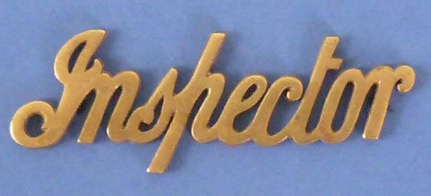
A script-lettering grade badge — Inspector — of the type used by Camborne and Redruth Tramways — brass. Author's Collection.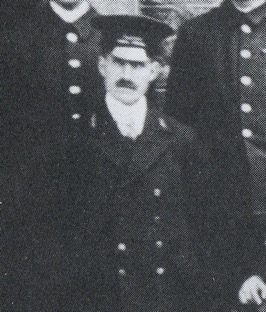
A blow-up of the 1920 staff photo above showing Inspector L E Wallace. By this time, inspectors' jackets had clearly been changed to a double-breasted design with the grade embroidered on the collars and the cap, the latter on a hat band.
Female staff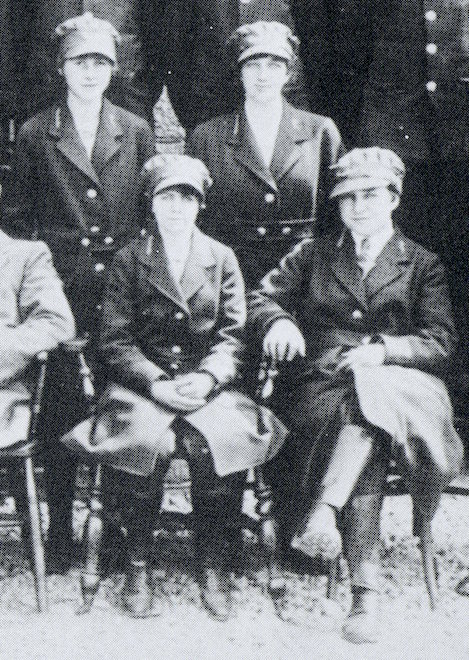
An enlargement of the 1920s staff photograph above showing four of the conductresses; they are wearing long single-breasted coats with trousers and gaiters. Clockwise from the top left: C Uren, ? Jory, E Rowe, G Bastion.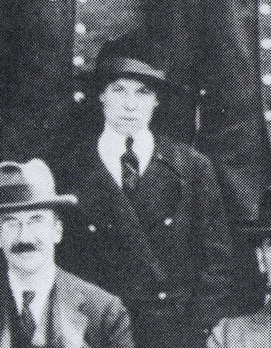
Another blow-up of the 1920s staff photograph, this time showing Inspectress Donavon.